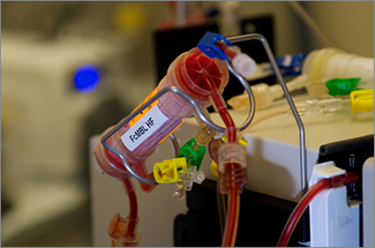Harvard Scientists Improve Sepsis Treatment Device

Scientists from the Wyss Institute at Harvard University have refined a device introduced last year that mimics the spleen and filters the blood of pathogens and toxins that cause sepsis. These improvements have made the technology more cost-effective, easier to regulate, and have moved the potentially life-saving device one step closer to human trials.
Sepsis is a complication of bodily infection, usually triggered by bacteria, fungi, or viruses. In severe cases, the immune response to infection can overwhelm the body with inflammation and a subsequent cascade of rapidly developing complications, leading to septic shock and organ failure. The National Institute of Health (NIH) estimates that one million U.S. patients suffer from sepsis every year, and between 28 and 50 percent of cases are fatal.
Traditionally, antibiotics are used to treat infection, but these are not effective against all pathogens and it can take too much time to determine which antibiotic will work best —especially in the era of the superbug. In septic cases, dead pathogens that have been killed by antibiotics can split apart, releasing toxins into the blood stream. Unless they are filtered out, these toxins can still pose a significant risk to the patient.
A research team, led by Wyss Institute founding director Donald Ingber, has developed technology that works alongside antibiotics to filter dangerous invaders from the bloodstream, and their research shows that the newest prototype is 99 percent effective against E. coli and Staphylococcus aureus, said the researchers in a press release.
The key to the design, originally published in Nature Medicine last October, is a genetically engineered version of a blood protein called Mannose Binding Lectin (MLB), which can bind to a variety of different pathogens, both living and dead. The Wyss Institute’s FcMLB, when used in an external filtration device, can capture from circulating blood many of the toxic invaders that commonly cause sepsis.
The original prototype used a complex system of FcMLB-coated magnetic beads and microfluidic chambers that were not cost effective and represented some unnecessary regulatory hurdles. The newer prototype incorporates FcMLB onto hollow fiber filters already FDA-approved for dialysis machines.
“Using the device… alongside antibiotics, we can quickly bring blood back to normal conditions, curtailing an inflammatory response rather than exacerbating it,” said Tohid Fatanat, first author of the current study, to be published in October’s Biomaterials.
The two previous studies showed the device to be effective against human pathogens in small animals, and the next step is a proof-of-concept study in larger animals. Because so many components are already approved for other devices, the team is confident that the preclinical studies will proceed without obstacle.
“Since the development of earlier prototypes of the device, we’ve applied the Wyss model of de-risking the technology to prime it for commercialization,” said Ingber. “Our goal is to see this move out of the lab and into hospitals — as well as onto the battlefield — to save lives within years, rather than decades.”
